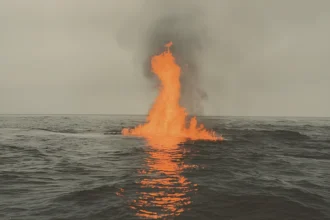German Scientists Turn Toilet Waste into Ship Fuel
Have you ever thought that what goes down your toilet could help power big ships? According to Clean Energy Wire, scientists in Germany have found an amazing new way to turn wastewater into clean fuel for ships. This is not science fiction – it’s happening right now at a special plant in Mannheim, Germany, where everyday waste becomes valuable fuel.
How Waste Becomes Clean Fuel
The clever process works by taking the smelly gas (called biogas) that comes from treating sewage and turning it into something called methanol. This methanol is a special liquid that can power ship engines without adding harmful gases to our air.
- Step 1: Collect biogas that naturally forms when bacteria break down waste at treatment plants
- Step 2: Clean and purify this gas to make it usable for the next steps
- Step 3: Separate out the carbon dioxide (CO₂) from the biogas mixture
- Step 4: Combine this CO₂ with green hydrogen (made using clean electricity)
- Step 5: Transform these ingredients into methanol fuel through a special chemical reaction
This special method was created by a team connected to the Karlsruhe Institute of Technology (KIT) and a new company called ICODOS. What makes it really special is that it doesn’t add any new carbon to our atmosphere.
Why This Matters for Our Planet
Ships are big polluters that add about 3% of all greenhouse gases worldwide. Finding cleaner fuels for these giant vessels is very important if we want to fight climate change.
Volker Wissing, Germany’s minister for digital affairs and transport, said: “To achieve our climate protection goals, we must keep all technological options open.” This new approach is one important piece of the puzzle in cleaning up transportation.
The benefits of this toilet-to-tank technology go beyond just cleaner ships:
- Less Pollution: Ships can run on fuel that doesn’t add new carbon to our air
- Energy Independence: Countries can make their own fuel instead of importing it from far away
- Waste Utilization: Something we normally just process and forget about becomes valuable
- Chemical Industry: The methanol can also be used to make other products like plastics and medicines
The Mannheim Plant: Testing Ground for New Technology
Right now, the test plant in Mannheim makes about 50 liters of clean methanol every day. That might not sound like much, but it proves the idea works!
| Feature | Performance |
|---|---|
| Daily Production | About 50 liters of methanol |
| Carbon Capture Rate | More than 99% of CO₂ is used |
| Energy Efficiency | Uses over 30% less energy for carbon capture than traditional methods |
| Source Material | Biogas from regular sewage treatment |
What makes this system special is that it’s smaller and more flexible than other fuel-making technologies. It can be turned up or down as needed, which is different from many big fuel plants that must run all the time.
Future Possibilities: From Small Test to Big Solution
The exciting part is how big this could become. Vidal Vazquez, who helped start ICODOS, points out: “In Germany alone, wastewater treatment plants could produce several million tonnes of sustainable methanol annually.”
Now think even bigger – there are about 80,000 wastewater treatment plants across Europe. If many of these plants adopted this technology, the impact could be huge!
- Scale Potential: From one plant to thousands across Europe
- Production Growth: From 50 liters daily to millions of tonnes yearly
- Application Expansion: Beyond ships to other industries needing clean fuel
ICODOS is already talking with other wastewater treatment plants to build more of these fuel-making systems. They believe their method is more efficient because it combines several steps into one process.
The Bigger Picture: Rethinking Waste
This story shows how creative thinking can turn problems into solutions. What if more of our waste could become valuable resources?
While experts note that making synthetic fuels uses quite a bit of energy, they should be used where direct electricity isn’t possible – like in big ships crossing oceans.
The next time you flush, remember that your waste might someday help power the ships that bring products to your local stores. This is just one example of how circular thinking can help us fight climate change in surprising ways!










